Content
Using my experience, reviews of gardeners from the forum and neighbors in the country, I will list here the best varieties of cabbage. Moreover, these varieties are suitable for the Urals and Siberia, as well as for central Russia.
Cabbage varieties with photos and descriptions, reviews
June cabbage, characteristic
An early ripening variety of cabbage, intended for fresh consumption, that is, immediately on the table. The heads of cabbage of this variety are round, weighing up to 2.5 kg. The color of the head is pale green with a slight waxy bloom. The density is average.
The variety is resistant to cracking. Harvesting "June" cabbage is carried out 60-70 days after planting seedlings. An important quality of this variety for the regions of the Urals and Siberia is that it tolerates frosts down to -5 degrees.
June cabbage yield: 6 kg / m2 sq.
Cabbage Zarya
The best early (118 days from germination to technical ripeness) variety of cabbage, resistant to cracking. Heads of cabbage are round, small, of medium density, weighing up to 2 kg. A variety for fresh use.
The Zarya variety gives high yields even with a low use of nitrogen fertilizers. High yield, good ripening and high commercial qualities of fruits are the indisputable advantage of this variety.
Cabbage yield Zarya: 3.4 - 10 kg from 1 sq.m.
Cabbage Express F1, description, photo
An early ripe hybrid of domestic breeding white cabbage. The period from full germination to the beginning of technical ripeness is 60-95 days.
The rosette of leaves is raised. The leaf is small, light green with a slight waxy bloom, flat.
The head of cabbage is round, medium density, uncovered, medium density, whitish on the cut. The outer and inner stumps are short. The average weight of the head is 0.9-1.3 kg. The taste is high quality.
Cabbage yield Express: up to 3.8 kg from 1 sq. m.
Advantages of the hybrid: high yield of marketable products, excellent taste, friendly formation of early products.
Cabbage hybrid Express F1 is included in the State Register of the Russian Federation for the Central and Central Black Earth Regions.
Cabbage Gift, photo
One of the best medium-late varieties of white cabbage for pickling and pickling. From the moment of planting seedlings to harvest, 110-120 days pass.
Light green, dense heads of cabbage, rounded or flat-rounded, as if covered with a waxy coating. Usually their weight is from 2.5 to 4.5 kg. The variety has excellent taste and is recommended for fresh consumption and fermentation.
Cabbage yield Gift - up to 10 kg from 1 sq.m.
It is advisable to plant seedlings according to the scheme: 60 cm x 50 cm. This variety is recommended both for growing in the Urals and Siberia, and in other regions of Russia.
Cabbage Aggressor F1, description
A popular mid-late ripening (from germination to fruiting 115-120 days) hybrid of Dutch selection, with high growth rates, stable yield under any conditions and the ability to short-term storage (up to 5 months).
The head of cabbage is flat-rounded, medium-sized, leveled, dense, weighing 3-5 kg. Resistant to cracking. Does not require special care. Perfect for risky farming zones (Siberia and the Urals). It tolerates a lack of nitrogen nutrition and unfavorable weather conditions.
Cabbage yield Aggressor: 4.3-6.5 kg from 1 sq.m.
High yield of marketable products and excellent taste make Aggressor cabbage ideal for fresh consumption, pickling and pickling. The hybrid is particularly resistant to damage from thrips and fusarium wilt.
Cabbage Slava-1305, description
The classic variety of cabbage, best adapted to the most varied climatic conditions. Ripening period 85-100 days.
Heads of cabbage are round, weighing from 2.5 to 4.5 kg, dense.
This variety is considered one of the most productive medium-sized varieties of white cabbage. In addition, it is stable, cold-resistant, and transportable. It also tastes good. The dense, round heads of cabbage are light green on top and white on the inside.
Slava is the best variety of cabbage for pickling and pickling.
Cabbage yield Slava - up to 12 kg from 1 sq.m.
Cabbage Amager 611
A late-ripening variety of cabbage, ripening occurs 115-120 days after full germination. Heads of cabbage are round-flat, dense, weighing 3-3.5 kg.
Amager is the best variety of late cabbage, it is perfect for pickling. The taste only improves during storage.
Productivity of cabbage Amager 611: 5 - 6 kg from 1 sq.m.
Late Moscow cabbage
One of the most productive large-fruited cabbage varieties.
The weight of one head of cabbage is usually 7-8 kg, the limit is 15 kg. Heads of cabbage are round, green.
This is one of the best sauerkraut varieties.
Cabbage yield Moscow late: 10 - 12 kg from 1 sq.m.
Cabbage Megaton F1, description
High-yielding, medium late (102 days from germination to fruiting) hybrid of Dutch selection.
The head of cabbage is flat-rounded, dense, weighing up to 15 kg. Cabbage Megaton - hybrid No. 1 for fermentation, with high taste. Also suitable for processing and fresh consumption.
It is the most productive medium-sized cabbage hybrid. Differs in high resistance to fusarium. Demanding on soil moisture and needs high doses of fertilizers.
Megaton cabbage yield: 5.86 - 9.34 kg per sq. m.
Rinda Cabbage F1
Excellent mid-early (95-105 days from germination to fruiting) hybrid of Dutch selection.
Heads of cabbage are large, round, with a dense and thin internal structure, weighing 5-8 kg, white on the cut. The stump is small. It is intended for fresh consumption, fermentation and short storage (from 2 to 4 months).
White cabbage Rinda f1 is distinguished by the evenness of the heads, high yield in various climatic conditions, and the ability to survive for a long time on the vine.
Rinda cabbage yield high.
Cabbage Hope
Mid-season (from germination to ripening 115-135 days), a productive variety of cabbage.
The head of cabbage is flat-round, pale green, weighing up to 5 kg. Resistant to cracking. The taste is high. Recommended for fresh consumption, fermentation and short-term storage (up to 3 months). Transportability is good.
Cabbage yield Hope - up to 13 kg / m².
Cabbage Gingerbread Man
A high-yielding late-ripening hybrid variety of cabbage that ripens only 150 days after germination.
Heads of cabbage are dense, round, weighing up to 5 kg, resistant to cracking. The inner stump is short. Heads of cabbage are green above, white in section.
The variety is resistant to cabbage bacteriosis, as well as to fusarium leaf wilting, to white and gray rot. Cabbage Kolobok is ideal for storing it for the winter, as well as for pickling. In good conditions, the heads of this variety can be stored until May next year.
Cabbage yield Kolobok: 7 - 12 kg / sq. m.
Sowing seedlings in mid-April. It is advisable to plant seedlings in the ground 50 days old according to the scheme 50 × 70 cm.
These are varieties and hybrids of cabbage for open ground.
We recommend purchasing cabbage seeds of excellent quality in the Sady Rossii online store.
If you grow other varieties of cabbage and they delight you with excellent taste and bountiful harvest, share their names with us in the comments. After all, it is impossible to try all varieties at once, but you want to plant only the very best. If possible, attach a photo of the cabbage you have grown.
White cabbage is an incredibly healthy vegetable with a rich vitamin and mineral composition. This explains its popularity among gardeners.The cultivation rules are not complicated, but the basis for the yield depends on the choice of the variety.
Varietal variety of white cabbage
In the old days, there was really a shortage of seed material due to limited supplies from the near and far abroad, therefore, the seeds were often harvested from the usual varieties.
For more than 20 years, the situation has changed radically, and the varietal assortment of many gardeners continues to consist of 2-3 positions. And in vain, because new developments have no less valuable qualities, which consist in resistance of cabbage to diseases and pests.
This is especially important when you consider that the moisture-loving plant literally attracts insects and fungi.
This article discusses early, mid-season and late-ripening varieties of a popular vegetable with a description that will expand the variety of crops grown in your garden and in the Urals and in the middle lane.
Most Popular
The variety of cabbage is selected not only taking into account the winter and climatic characteristics of the region, but also by appointment... The mineral and vitamin composition of each plant is different, but it is also influenced by the conditions of agricultural technology and the type of soil.
In order to choose the appropriate option it was easier, the varietal assortment is divided into groups, united by a common feature.
The best late varieties of cabbage for long-term storage
Aggressor Is a mid-late hybrid developed by breeders from Holland. Differs in minimal care and resistance to fusarium, thrips damage.
Vegetation lasts up to 120 days, you can sow seeds directly on an open bed. A ripe vegetable weighs 3-5 kg. Shelf life and processing - up to 5 months.
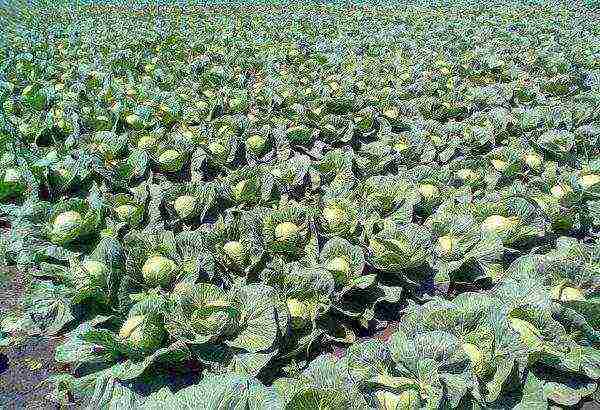 Aggressor
Aggressor
Amager - late cabbage with a ripening period 120-147 days... The heads are round-flat green, sometimes with a bluish tinge, weight about 3-4 kg.
When planting, the scheme is used: 3-4 plants per 1 m2. For six months, the nutritional value and presentation are preserved. Weather cataclysms and violation of the watering regime do not violate the density of the structure and the integrity of the head.
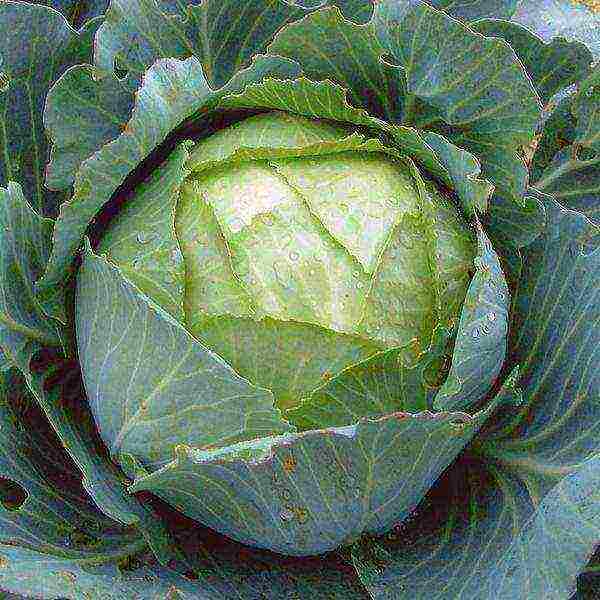 Amager
Amager
Valentine - growing season 155-180 days after transferring seedlings to open beds. The gray-green heads have a slight waxy coating, the weight tightens up to 4 kg.
Cabbage retains its taste and presentation until the beginning of the next season (June). The hybrid is tolerant to fusarium, gray rot. The head of cabbage does not crack due to violations of the moisture regime.
When planting, the scheme is used: 2-4 plants per 1 m2.
 Valentine
Valentine
Gingerbread man - hybrid forms heads later 115-125 days after planting seedlings. Round fruits have a dense structure, the average weight is 2-3 kg. Planting scheme: 3-4 plants per 1 m2.
Due to its good immunity, it exhibits tolerance to punctate necrosis and thrips. For 8-10 months, cabbage retains its nutritional value and presentation.
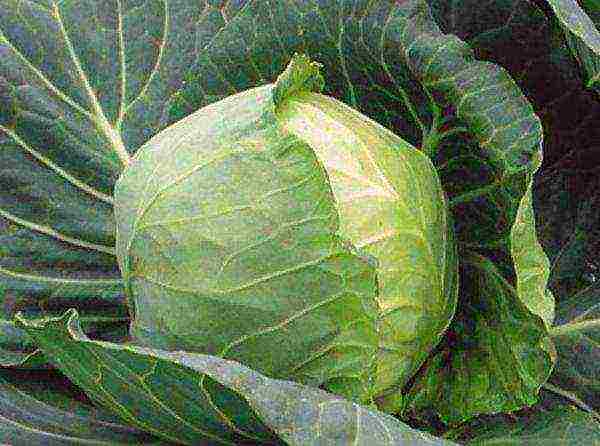 Gingerbread man
Gingerbread man
Mara - very dense heads are not susceptible to cracking, the average weight is 3 kg. The variety is distinguished by good taste, transportability and long shelf life (more than 7 months).
The main advantage is resistance to the accumulation of nitrates and radionuclides. Vegetables are harvested through 160-175 days after transplanting seedlings.
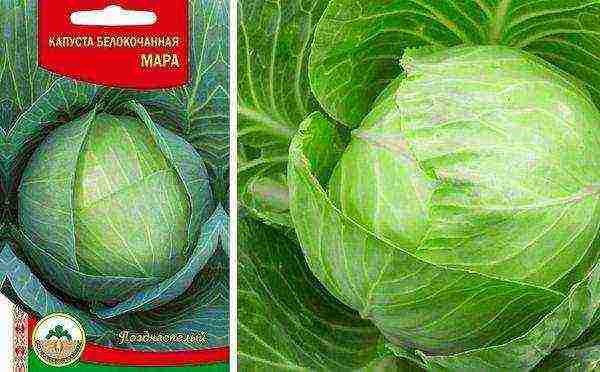 Mara
Mara
Moscow - a variety developed by domestic breeders, who took into account the climatic features and possible problems with pests when growing.
Harvesting begins later 130-140 days after disembarking seedlings. Gray-green rounded heads of cabbage weigh 4-7 kg on average. When planting, the scheme is used: 2-3 plants per 1 m2.
Cabbage is resistant to cracking, has a delicate juicy pulp. Without loss of taste and presentation, the vegetable is stored for 6-8 months.
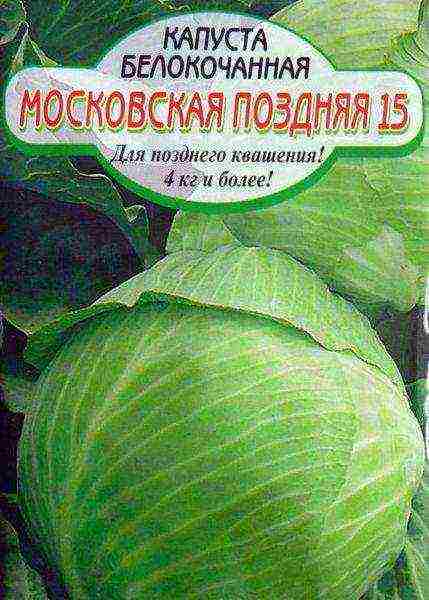 Moscow
Moscow
Mid-season white cabbage
Megaton - the hybrid matures in 102 days after planting seedlings.The great need for moisture and fertilizers strengthens the immune system, which resists many diseases and insect infestations.
The round-flattened gray-green head weighs up to 15 kg. The location of the holes when planting: 3 plants per 1 m2. Duration of storage without loss of nutritional qualities and presentable appearance is 4-6 months.
Merchant's wife - a disease-resistant high-yielding variety, distinguished by simple agricultural technology. About 500 centners are removed from a hectare (head weight up to 3 kg). When planting, the scheme is used: 3-4 plants per 1 m2.
Harvesting begins later 130-150 days after transferring seedlings to the beds.
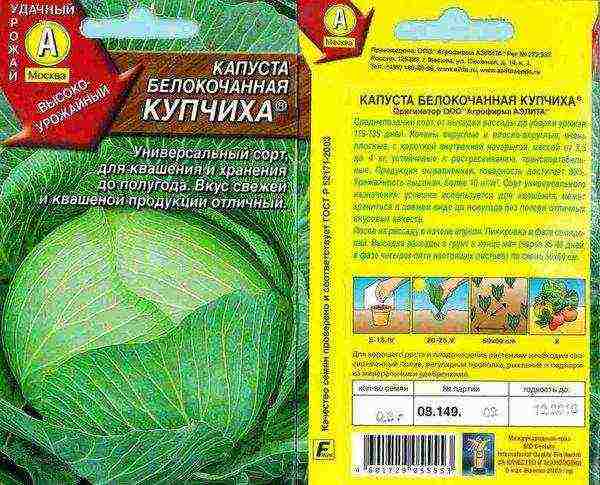 Merchant's wife
Merchant's wife
Atria - the fruit of the works of Dutch breeders with the growing season 110-120 days... The head of cabbage has a round-flat head of blue-green color, the average weight of which reaches 5-7 kg. Often there are specimens of 8-8.5 kg. When planting, the scheme is used: 3 plants per 1 m2.
Thanks to its good immunity, it resists pests (in particular thrips) and fusarium. The commercial and taste qualities are preserved for 4-6 months.
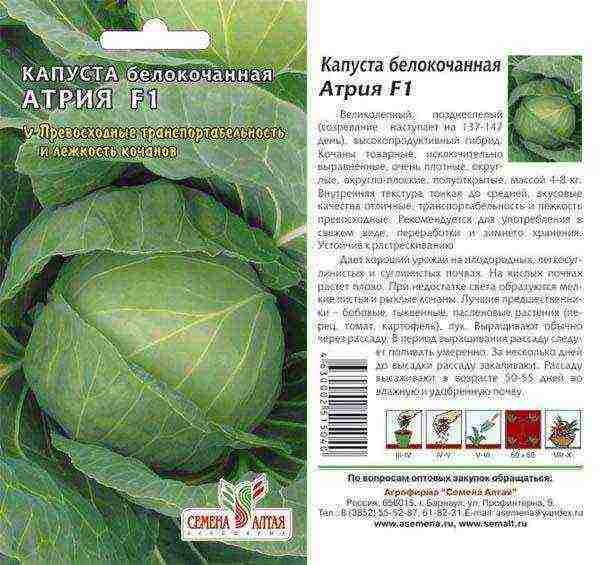 Atria
Atria
Glory - the fruit of the work of Russian breeders, the growing season is 120-130 day after planting seedlings.
Round heads have a light green color with a grayish tinge, the weight tightens up to 3-5 kg. When planting, the holes are arranged according to the scheme: 3-4 plants per 1 m2.
The advantage of the variety is its taste, the disadvantage is short storage (about 2 months). Glory is one of the best pickling options.
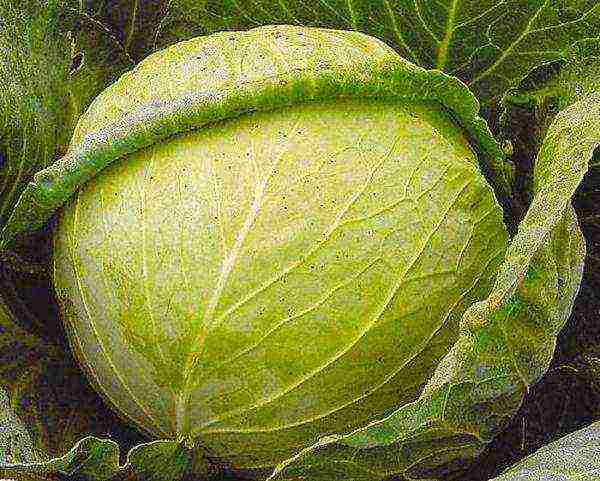 Glory
Glory
Sugar queen - the hybrid ripens after planting seedlings through 120-140 days... Dense rounded heads have a slightly greenish tint, weighing up to 4 kg.
When planting, the scheme is used: 3 plants per 1 m2. A universal variety, used fresh and for salting. The shelf life without loss of valuable qualities is 3-4 months.
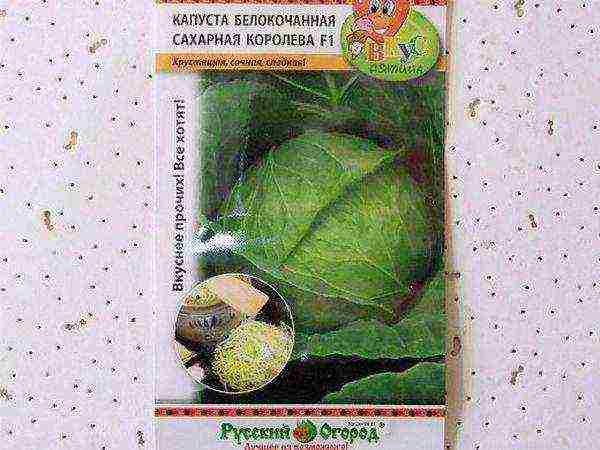 Sugar queen
Sugar queen
Early ripe
Rinda - the ripening period of the hybrid is 75-80 days after disembarking seedlings. Round heads weighing up to 7 kg have a green color and a dense structure. Hole layout: plant 3-5 plants per 1 m2. Differs in unpretentiousness to weather conditions.
The shelf life without loss of taste and presentation does not exceed 4 months.
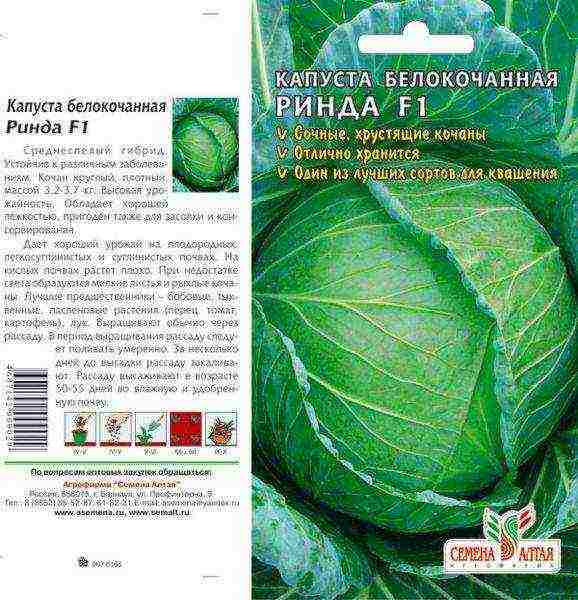 Rinda
Rinda
Kazachok - an early hybrid is characterized by early maturity, you can harvest through 45-55 days after disembarking seedlings. The weight of the medium-sized light green head is 1.5 kg.
The scheme used for planting: 5-6 plants per 1 m2. Recommended for cultivation under any kind of film and in the open field. Cabbage resists the causative agents of mucous bacteriosis and black leg.
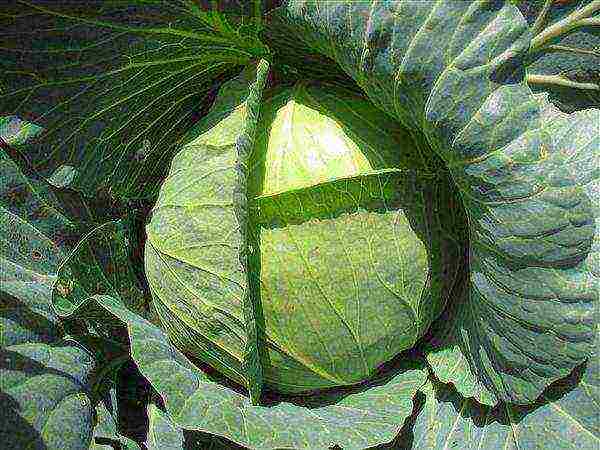 Kazachok
Kazachok
June - the variety is ready for planting in open ground already at the beginning of May, after 45-50 days you can harvest. The structure of the head is of medium density, the weight reaches 1.4-1.7 kg. When grown on highly fertile soils, the weight of the head of cabbage reaches 5 kg.
The layout of the holes when planting: 3-5 plants per 1 m2. Cabbage is distinguished by the amicability of the emergence of seedlings and excellent taste.
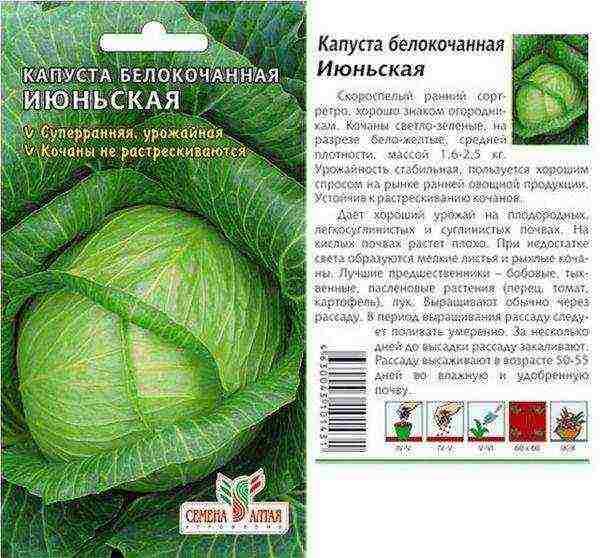 June
June
Tobia - Dutch hybrid characterized by resistance to fusarium wilt. The layout of the holes when planting: 2-3 plants per 1 m2. Dark green round-flat heads weigh up to 7 kg. Fruit ripening occurs later 85-90 days after disembarking seedlings.
It has a strong root system, if the irrigation regime is violated, the head of cabbage does not crack. It retains its taste and marketability for 5-6 months.
 Tobia
Tobia
Varietal variety will ensure productivity even in difficult weather conditions, because each plant has its own immunity to diseases and pests. The taste qualities of the varieties stimulate new experiments, which continue already in the kitchen.
Winter (or late-ripening) cabbage varieties are most suitable for salting and long-term storage until spring.It is them that summer residents prefer to grow in order to prepare enough of this useful vegetable for the winter to feed the whole family.
Growing white cabbage
Description of late cabbage
Many late varieties have been bred. They differ mainly in the duration of ripening. While early varieties take three months from germination to fully ripen, mid-season varieties may take four months, then some varieties of late cabbage mature only six months after the start of growth from seeds.
Description of late cabbage
This long wait is rewarded:
- equally long shelf life;
- high yield of varieties;
- excellent transportability of heads of cabbage;
- readiness to preserve all valuable substances, taste and textural properties during salting, pickling and fermentation.
By the way! Varieties intended for long-term storage improve their palatability over time. In addition, in cabbage, unlike other vegetables and root crops, nitrates do not accumulate during the time it is stored.
Cabbage
The second difference between different types of cabbage ripening in terms of maturation is agricultural technology. In general terms, it is similar not only for all cabbages, but also for many crucifers. But the timing of sowing, germination, planting and some growth conditions differ in detail in late cabbage from its mid-ripening and early-ripening "relatives".
By the way! Some varieties of late-ripening cabbage can stay intact, under appropriate conditions, until the next harvest.
Growing features
Growing cabbage in a greenhouse
In different regions, depending on the climate, the seeds of late cabbage varieties are planted at different times. But always, in all climatic zones, this is a seedling method of growing. For late varieties, seedlings are grown at home (in extreme cases, in a heated greenhouse or greenhouse). In the southern regions, it is possible to sow seeds on a special seedling bed under a film cover.
Stimulation and disinfection of seeds
Seeds
Before sowing late cabbage seeds, they need to be disinfected. Soaking in hot water is sufficient for disinfection. The temperature should not be higher than + 45 ° С. It is necessary to keep cabbage seeds in water for a quarter of an hour, placing them first in a rag bag.
Disinfection of seeds
How to keep the required temperature in the container for a certain time?
- Put a dish of water on the heater (after checking the temperature of its heating in advance for half an hour).
- Put the container in another container, pouring water into it, ten degrees hotter (a kind of water bath, just not on fire).
- Disinfect seeds in a multicooker on the "Yogurt" mode.
Important! The heating procedure will not only destroy the microbes that may be inside the seed, but will also contribute to the speedy germination by activating the growth point of the embryo.
Disinfection of seeds with potassium permanganate
After disinfection by heating, the seeds must be quickly cooled by lowering them for one minute under cold running water.
Soaking the seeds in a fertilizer solution will help accelerate germination and make the seedlings even more uniform. It can be any mineral complex. It is best to take a regular nitrophosphate. The proportions for the preparation of the solution are 5 g of granules per 500 ml of water. Room temperature water. Dissolve thoroughly. Keep seeds for 12 hours.
Preparation of seedling containers and soil
Cabbage dives well, so it can be grown initially in any convenient or available containers. If pots are available, use pots. There are boxes, sow in boxes.
Peat seedling pots
It is more convenient to plant cabbage on a ridge or in a greenhouse from individual pots with a diameter of about 8 cm. By the time they move to the garden, the seedlings should have four adult leaves.
The soil for sowing cabbage does not need heavy. Peat is traditionally used.If possible, part of the humus is mixed with part of the sod land, sand can not be added. Both peat and mixed substrate must be seasoned with wood ash. About a tablespoon is used per liter of substrate. The ash is sieved before this. Then it is thoroughly mixed with the soil.
Soil for cabbage seedlings
If you have not steamed the soil mixture, then be sure to spill it with Trichophyte solution or pink potassium permanganate solution
Sowing
You can sow late cabbage seeds at the end of February. It can take up to 60 days before planting seedlings in the garden. The latest sowing dates for late varieties are mid-March. Sowing later in the middle lane is impractical, the heads will not have time to ripen.
Advice! If you are late with sowing late-ripening varieties, sow mid-ripening ones. Some mid-season varieties, for example, "Gift", are stored for up to four months, have good data for canning and can be used fresh.
Spread the seeds
Add seeds
Sowing takes place in shallow grooves, about 2 cm deep. The distance between the crops in the box is 5 cm.When two full-fledged leaves appear, the seedlings will have to be thinned so that a distance of at least 5 cm remains between the seedlings.If you are sowing in a pot, spread 3-4 seeds at the corners of an imaginary square, on top of the soil. Fill on top with a two centimeter layer of peat. Crops are watered and covered with foil.
Place the bowl in a plastic bag and keep the sowing until germination at a temperature of about 20 ° C
After germination, which appears on the 5-7th day, the film is removed immediately and is no longer used.
Watering cabbage seedlings
Preparing the cabbage bed
Preparing the cabbage bed
Late varieties need a lot of sunlight, heat and moisture for the heads of cabbage to fully ripen. Only finally ripe heads of cabbage can be stored all winter until summer. Therefore, the landing site is chosen open. The soil is fertilized with organic matter in the fall. Cabbage loves organic fertilizers - this is the best fertilizing option for this plant. Late cabbage especially needs fertilization of the soil. Up to 7 kg of rotted organic matter is used per 1 m². Can be fertilized with plant compost. But animal organic matter in addition, in the form of a solution, should be used for pre-plant feeding and for periodic feeding, of which at least three are carried out during the growing season.
Transfer
Seedling cabbage
At the end of April, holes are dug in a dug ridge according to the number of seedlings. Seedlings move into moist soil, with a moist clod, do not deepen. Watering is necessary abundant. The first feeding is carried out on the twentieth day after planting.
Cabbage planting scheme
Planting cabbage in the ground
Planting cabbage seedlings
Fill the hole with water
The hole is kept free of weeds. The soil is loosened. After the beginning of the formation of the outer stump, the plant must be spud.
The best varieties of late-ripening cabbage
There are not so many varieties of cabbage, unlike other garden vegetables. Against several hundred varieties of tomatoes, cucumbers, peppers - only a few dozen early, medium and late cabbage varieties. Some of them, moreover, were bred back in the USSR from numerous hybrids, so they cannot be called the best. The most popular, most frequently and successfully cultivated are the following late varieties.
"Aggressor"
Aggressor is a popular hybrid variety
Marked "F1", it is a hybrid in the first generation. It can be grown in any region. Its characteristic features are delayed development at the stage after planting seedlings; unpretentiousness and ease of plant care.
By the way! This variety grows with little or no maintenance. In any case, you do not need to look after him as carefully as for his brothers. You can "forget" to water, feed (withstands a lack of nitrogen and drought).
Aggressor F1
Color - green with blue. There is a waxy coating. The structure of the head of cabbage is of high density.The hard, knocked down fruit reaches five kilograms. Grown within four months. After 120 days from germination, it reaches full ripeness. Almost no cracking occurs, prolonged cleaning is possible almost until the first frost.
The variety is resistant to black leg, not affected by fusarium, thrips, not susceptible to late blight. One of the best for fermentation, stored in heads of cabbage for five months.
Video - Cabbage "Aggressor F1"
"Mara"
One of the most popular varieties of Belarusian selection. The growing season is long - up to 165 days. Medium heads - 4 kg. But the taste is exceptional. Used for fermentation whole, heads, kept fresh for about eight months, until early May. Differs in high productivity.
White cabbage. Variety "Mara"
Bluish waxy bloom on the thick outer leaves is pronounced. The variety is grafted with resistance to rot.
"Moscow"
White cabbage "Moscow" late
This is a giant variety. The heads can be up to ten kilograms. Ripens, however, in just 130 days. It is considered one of the most productive varieties. The surface color is green-gray. The inside of the section is white with yellowness. The taste is not just good - it is excellent. Lots of sugars, ascorbic acid, minerals.
By the way! Able to withstand a drop in temperatures down to -6 ° C ... 8 ° C. Therefore, the dates of disembarkation and harvesting can be shifted to an earlier (spring) and later (autumn) time.
Moscow cabbage
With a dense consistency, it is juicy. Resistant to cracking and most cruciferous diseases. Only slugs and aphids need processing.
Stored at + 5 ° C for 9 months or more.
"Amager"
"Amager"
The variety is ideal for fermentation and the production of any blanks. The heads are small - up to five kilograms. The density is increased. The color is green-gray with a bloom. White inside. There is resistance to root rot and fungal infections.
By the way! It is a cold-tolerant variety, but it does not tolerate heat well and reacts negatively to drought. Therefore, it needs additional watering.
The growing season of the variety lasts 160 days. The average shelf life is up to six months. Therefore, this variety is best used to create winter stocks of pickles. Perfectly transported, not prone to damage, does not crack, cleaning can be done mechanically.
"Megaton"
Cabbage "Megaton f1"
The earliest among the late hybrids, after the leader of the "Aggressor". The growing season is within four months. The head of cabbage grows dense, weighing up to 5 kg. This is a Dutch hybrid, and the breeders took care of the "brainchild" as much as possible, providing it with immunity not only to diseases, but also to insect damage.
Excellent transport capabilities. Quite high taste parameters. It is not stored for long - five months. Used for fermentation. Needs frequent watering and an increased rate of mineral fertilizing.
"Snow White"
Cabbage "Snow White" (late)
A late variety, it is considered universal, since it is suitable both for storage for eight months, and for all types of salting and canning, as well as for fresh consumption.
By the way! High healing properties of this variety of cabbage and its increased nutritional qualities are noted. It is considered beneficial for children as it supplies many of the nutrients needed by a growing body.
Fully ripe forks reach 4 kg. The growing season is 160 days. Leaves of beautiful turquoise color, white dense inside. Not damaged by delayed harvest and transportation.
"Valentina"
"Valentina"
A very popular variety among gardeners of the middle lane. Domestic hybrid. It ripens for a long time - up to 180 days. The weight characteristics of a head of cabbage do not exceed 4 kg. Stored for 8 months. But with all these "ordinary" qualities, "Valentina" is distinguished by outstanding taste qualities. It is characterized by high sugar content, crispness, and fork density.Use is possible in all cabbage "hypostases". But best of all, besides perfect storage, cabbage tolerates pickling.
White cabbage "Valentina"
"Kolobok"
"Kolobok"
Also a popular hybrid with perfectly rounded five-kilogram heads that ripen within 150 days. Wax bloom is pronounced. The middle is snow-white. A very dense head of cabbage. Stored for 7 months. Can be used for fermentation. This variety, with such "alright", one-to-one heads of cabbage, is distinguished by high marketability, simultaneous ripening and ease of harvesting. Does not require specific maintenance. It is susceptible to cabbage diseases and pests.
"Sugarloaf"
Cabbage variety "Sugarloaf"
The speaking name of this late variety indicates its high sugar content. There is absolutely no bitterness in it, so it is used mainly fresh. Not only organic sugars are contained in it in large quantities, but also many minerals, and a number of vitamins, led by ascorbic acid.
Sugarloaf giant cabbage
By the way! Resistance to fusarium, bacterial diseases, keel and an eight-month shelf life contributes to the popularity of the variety.
After 160 days from the beginning of the growing season, the heads of cabbage gain a mass of 3.5 kg. This is quite a bit when you consider that some varieties grow three times heavier. But the nutritional value is taken into account when choosing a cultivar for cultivation, so Sugarloaf is not in the last place among the popular late cultivars of white cabbage.
"Lezhky"
"Lezhky"
This hybrid, named eloquently for its properties (high keeping quality), has, nevertheless, a very small weight, and therefore size, heads of cabbage. The maximum up to which the forks grow is 3 kg. Ripens for 155 days. Has above average palatability immediately after harvest. Then, during storage, they rise significantly. The variety can be stored until June, a full nine months. Moreover, they even begin to ferment and preserve it not immediately after collection, but in the middle of the shelf life. At this time, around February, the heads of cabbage reach the highest sugar content.
"Triumph"
"Triumph"
An extremely late ripening hybrid, ripening 175 days. The mass of a head of cabbage does not exceed 4 kg. Recommended by summer residents for cultivation for a long and good keeping quality. Storage is possible up to 8 months. It tolerates all types of canning perfectly, keeping the vitamin composition unchanged. High juice content. Above the average density of a head of cabbage. Not prone to fusarium wilt. The yield is strong.
"Filibuster"
"Filibuster"
This "pirate" variety is a mid-late hybrid. It is preferred for a relatively short ripening period of 130 days. Small heads of cabbage - 3.5 kg. Shelf life to late varieties does not hold out, shelf life is no longer than 5 months. But you can ferment and preserve immediately after harvesting. Taste characteristics are equally high for both fresh and canned products.
Table. The timing and duration of the main stages of growing popular late varieties of white cabbage
| "Aggressor" | 50 | 120 | 5 |
| "Mara" | 60 | 165 | 8 |
| "Moscow" | 55 | 130 | 9 |
| "Amager" | 60 | 160 | 6 |
| "Megaton" | 55 | 130 | 5 |
| "Valentina" | 60 | 180 | 8 |
| "Kolobok" | 55 | 150 | 7 |
| "Sugarloaf" | 60 | 160 | 8 |
| "Lezhky" | 60 | 155 | 9 |
| "Triumph" | 60 | 175 | 8 |
| "Filibuster" | 50 | 130 | 5 |
5 best ways to store cabbage
Video - Planting late cabbage
.
Cabbage as an agricultural crop does not require care at the ripening stage. But experience has proven that such delusions harm cultivation. A common place for growing cabbage is open ground, and the choice of a variety for it is difficult. Characteristics of varieties will help determine the best species, how to properly care for, which garden crop to choose, and for what purposes you can use cabbage after ripening.

Growing cabbage in the garden is profitable and easy
What are the rules for growing vegetables outdoors?
In the preface, it was mentioned that cabbage requires care, contrary to the opinion widespread among gardeners. On the open ground, the fruit awaits many dangers than in a greenhouse. Threats can be classified according to basic categories, they look like this:
- Diseases.
- Pests.
- Animals.
- Unsuitable soil.
- External conditions.
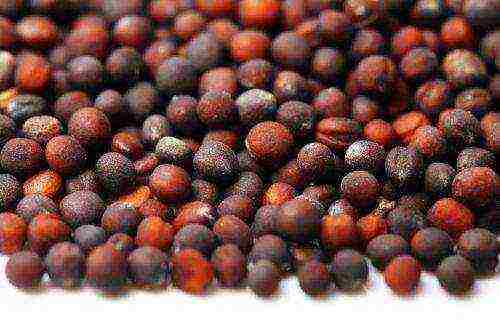
It is better to buy cabbage seeds from trusted companies.
Each factor has a detrimental effect on the development and growth of cabbage, and it is not recommended to turn a blind eye to these moments.
The best varieties for open ground Gribovsky-147
This variety of cabbage is a discovery for gardeners who grow crops in the open field. Gribovsky-147 belongs to the early maturing species: a distinctive feature is the heads of cabbage of medium density. The weight of each of them varies between 1-3 kg. Heads of cabbage and leaves with a pale shade of green. The variety Gribovsky-147 belongs to those that are characterized by a friendly formation. Sowing cabbage is best done in mid-April, planting in mid-May. Landing on an area of land - 40 by 60 centimeters.
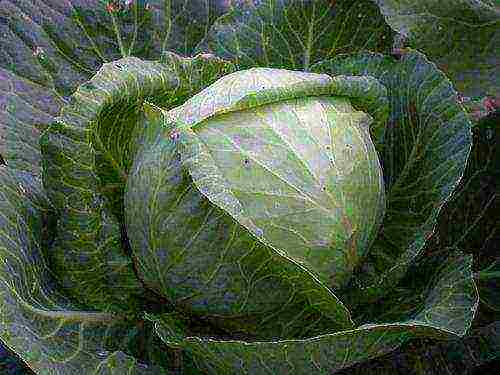
The Gribovsky 147 variety is great for a private farm
- It is necessary to grow cabbage of this variety outdoors carefully, attention should be paid to the acidity of the soil and shade.
- It is also important to protect the plant from pests and insects, for which it is recommended to stock up on specialized preparations.
- Dangerous for the Gribov culture and frosts, the species is planted late. Ripening of this variety occurs, depending on the conditions, in 90-120 days.
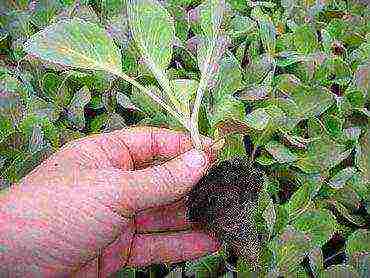
Growing through seedlings accelerates crop maturation
For one square meter of soil, you can get a yield of up to 7 kilograms of heads. Gribovsky-147 is irreplaceable for culinary masterpieces.
No. 1 polar K-206 (early maturing species)
The mid-early variety of cabbage "No. 1 polar K-206" is a widespread and successful variety for open ground. Experienced gardeners prefer the early maturing varieties of K-206. Distinctive characteristics of this variety: a compact rosette (half a meter diagonal), half-raised leaves and a rounded head of cabbage of the correct shape. Leaves with a grayish tint, although this variety is naturally devoid of them.
Variety No. 1 Polar K-206 bred for industrial cultivation in the northern regions
The diameter of a head of cabbage ranges from 15-25 centimeters, and its weight is up to 2.2 kilograms. It is important to note the yield. The minimum value is 6 kg, up to a maximum of 11 kg. The advantage of K-206 is its resistance to cracking on the head of cabbage. The flowering of this variety is minimal. In cooking, it is best suited for eating raw, salads and pickling.
Of the varieties suitable for outdoor use, this one contains the maximum amount of vitamins C and K.
Transfer
This variety is smaller, although it compensates for this with rapid growth and yield. This variety, growing in the open field, is distinguished by a head mass of 1.5 kilograms. The resistance to cracking of the Transfer variety is also high. The color is light green and the inside is white.
Agronomists classify a variety as one that produces a crop in the fastest possible time. Hybrid. Freeze "Transfer" also withstands positively.
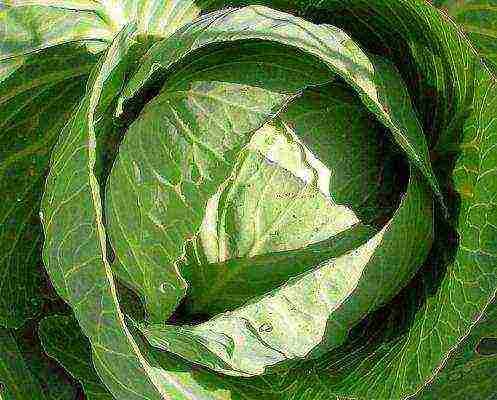
Cabbage Transfer cannot be dived, but sown in separate containers
The variety is grown for raw consumption. But it will also fit for cooking cabbage soup, borscht, cabbage rolls and other dishes. Seating starts in April. Seeds are sown through peat pots - Transfer does not tolerate transplanting well. The variety is susceptible to the red-colored flea beetle, therefore, it requires spraying with appropriate preparations to protect against the pest. "Transfer" ripens quickly, in 50 days - a record among varieties that are suitable for growing outdoors.
F Sprint
Another hybrid, the F Sprint, also borrowed the positive features of the Transfer. Among the similarities, the rapid ripening of the variety is noted - in the open field this process takes 55 days. The head of cabbage of this variety is round, the leaves are with a faint waxy bloom.F Sprint differs in density, which has a better effect on weight. The weight of a single specimen starts at 900 grams and reaches 1.8 kg. It is resistant to cracking, you can plant cabbage seeds early - already in early April. Friendly ripening is another characteristic of the variety. The yield reaches 10 kilograms per square meter of open ground. Already in June - July, the first plants for human consumption are obtained.
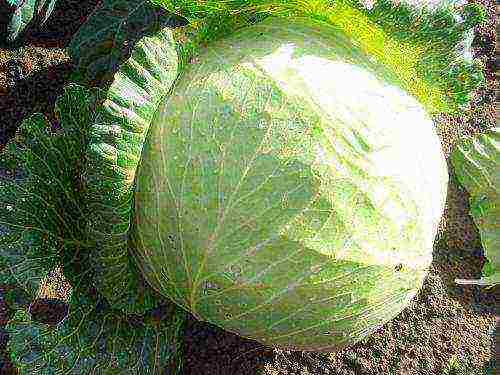
Sprint variety - very productive and perfectly stored until spring
F Sprint works best as an ingredient in salads. The marketable output is 92% - a record figure for cabbage.
Best features:
- Early variety.
- High productivity.
- Maximum exit percentage.
- Frost resistant.
- High density of heads of cabbage.
F Rinda
Grade F Rinda is a complete antipode of the twinned F Sprint, and exceeds the size and weight of a single head of cabbage many times. One plant weighs 4-6 kilograms. Its density is medium and the leaves are compact - using a standard planting net, you get acceptable yields. Rinda resists frosts well, but in conditions of a lack of moisture it does not live long - gardeners lose their crops due to the fact that they did not bother to better monitor the condition of the soil.
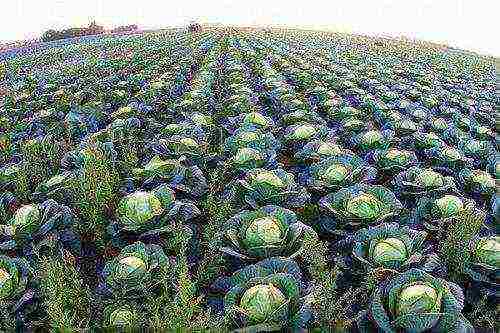
Rinda cabbage - a novelty for farms
Among the disadvantages of the variety, there is an increased demand for the level of lighting - payment for large heads of cabbage and high yields.
F Rinda cabbage is juicy and soft, which makes it the best ingredient for salads and other national dishes. A distinctive feature of the variety is the possibility of long-term storage. It can also be transported over long distances - the strength of the heads of cabbage is above average.
Key and best features of the variety:
- Little finicky to the climate.
- Stored for a long time.
- Perfectly transported.
- Has a pronounced taste.
- Small degree of damage from parasites and diseases.
Golden hectare
This variety is shown for open ground, but unlike the others presented above, it is medium early - its ripening period is slightly longer than the varieties of cabbage presented. This period is at least 100 days, and with a lack of heat - 150 days. The weight of heads of cabbage varies from one and a half to three kilograms, in warm climatic zones it can even exceed this figure. A golden hectare is better resistant to frost and transported over long distances. It is better to land in the ground according to the 60 by 60 centimeters scheme.

Cabbage Golden hectare time-tested
The yield is at least 5 kilograms per square meter. With proper care and the absence of diseases, the yield is up to 9 kilograms, which is higher than the average for medium early varieties.
A golden hectare is better suited for fresh consumption, as well as cooking cabbage soup, borscht and cabbage rolls.
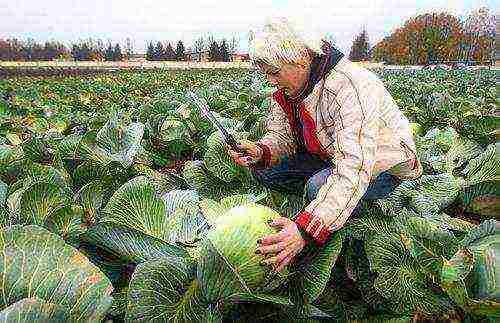
Harvesting cabbage Golden hectare
Typical and best features:
- Long ripening.
- Disease resistance.
- Early disembarkation.
- Undemanding to care and climate.
Gingerbread man
When talking about cabbage varieties that are suitable for planting in open ground, it is important to note the late varieties. Kolobok is a popular representative. Similar plant varieties are kept for the winter. The ripening period is not less than 130, and sometimes even 150 days. Heads of cabbage with a minimum weight of 3 kg, although they can reach the mark of 5 kg. A 50-day seedling is planted in the ground in early summer, and the seeds are pre-treated with heat for resistance to pests.
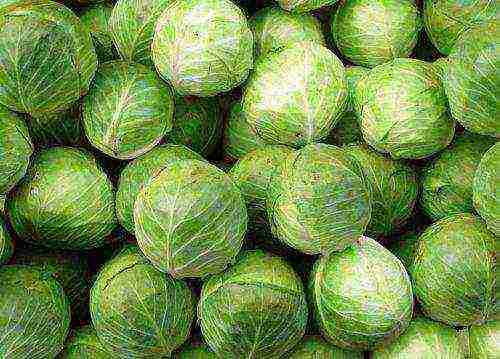
Kolobok variety sells well on the market
Harvesting of cabbages begins in October, which is convenient for many farms and gardeners: the load on them is less than in other months of the year.
Heads of cabbage with a density above average. Cabbage variety "Kolobok" is better suited for salads and pickling. It can be stored until early summer next year. Benefits and best qualities:
- Undemanding to climatic conditions.
- High frost resistance.
- Storage.
What diseases are exposed to cabbage varieties outdoors?
Diseases are a common factor that deprives gardeners of their crops - they cause damage. Agronomists call the disease of cabbage outdoors. Another name for this disease is black spot. Symptoms are easy to recognize: the plant is abundantly covered with necrotic formations in the form of brown spots of irregular shape: more often - an ellipse, less often - round.
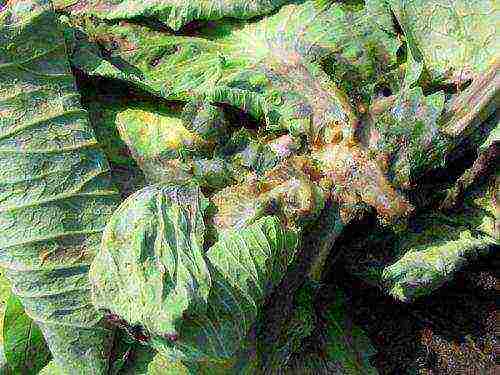
Cabbage rot is an insidious disease that can destroy crops
With the development of the disease, the formations acquire a concentric character and cover the surface of the plant. A black bloom is noticeable around them - spores of fungi, which become breeding grounds for the disease.
To prevent the seeds are heated at a temperature of 50 degrees for 15-20 minutes.
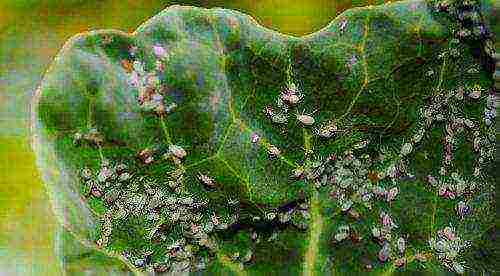
Aphids on cabbage suck out juices from plants
White rot is no less common. Rotting is possible from the head of cabbage and outside. In 80% of cases, the first symptom is plaque on the lower part of the leaves, which feels and visually resembles a cobweb. Infection occurs outdoors, due to increased acidity. Other common diseases: leucorrhoea, penosporosis, downy mildew and vascular bacteriosis are much less dangerous for this crop.
Subscribe Be aware of new products on our site


